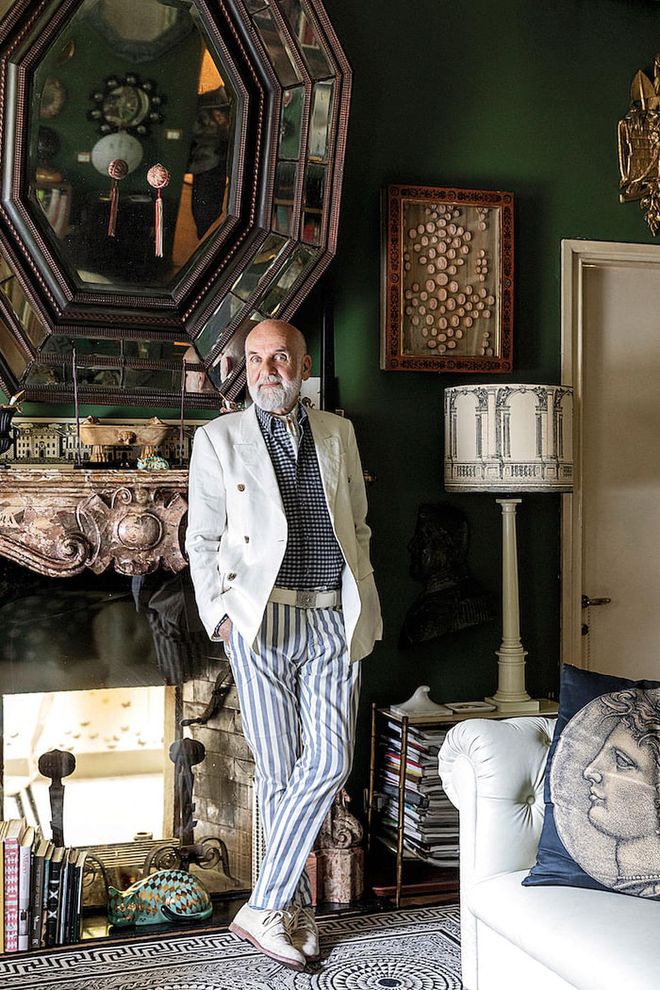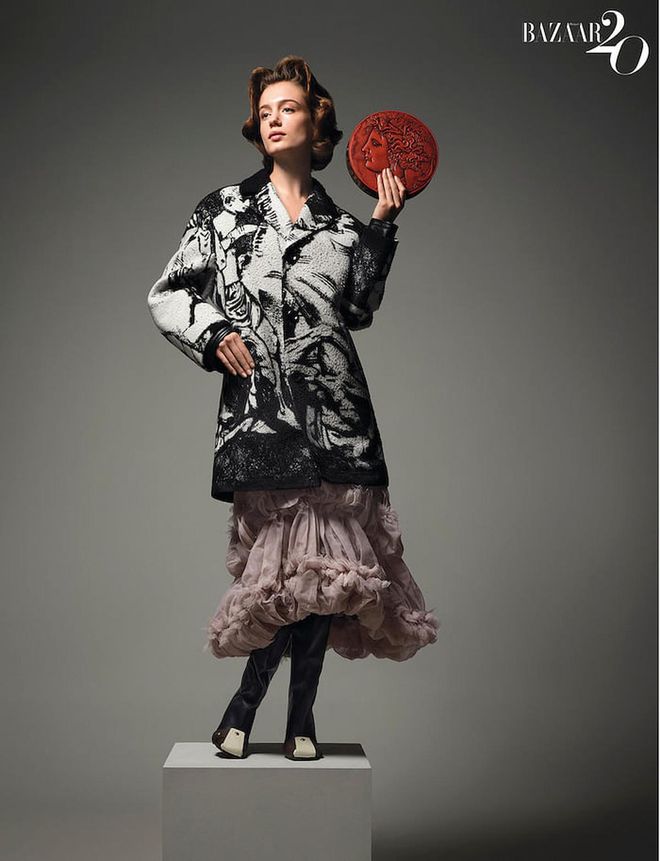Exclusive: Interview With Barnaba Fornasetti On The Louis Vuitton Collab
Through a collaboration with Fornasetti, the Louis Vuitton fall/winter 2021 collection became a spectacular meeting of minds, of fashion and art, and of the classical and the contemporary.

Founded in 1940 by Piero Fornasetti, Fornasetti sits at the intersection of art and design, and has become beloved the world over thanks to its irreverent approach to both. A healthy dose of surrealism and whimsy marks the studio’s output, be it candles, porcelain, furniture or wallpaper. Now, the brand has made a foray into high fashion with a Louis Vuitton tie-up. Inspired by the idea of clashing past with present, and classicism with the avant-garde, the surreal and everything in between, Nicolas Ghesquière, Artistic Director of Louis Vuitton’s womenswear, looked to the vast archives of Fornasetti and rendered its prints, motifs and drawings on both ready-to-wear and accessories. It marked the latest, and perhaps the biggest, in a long line of collaborations for the Italian design studio—now helmed by Barnaba Fornasetti, son of Piero. Ahead of a Fornasetti exhibition curated by Ghesquière, “Imagination Takes Flight: The World of Fornasetti Through the Eyes of Nicolas Ghesquière”, which is set to take place at Garage Traversi in Milan next year, Fornasetti sits down exclusively with us to talk about the magic of collaboration, the importance of the handmade and the power of dreaming.

Dress and bag, both by Louis Vuitton x Fornasetti. Skirt and boots, both by Louis Vuitton. (Photo: Wee Khim)
How did the collaboration with Louis Vuitton come about and why did it feel right for now?
The collaboration was the brainchild of Nicolas Ghesquière. During a visit to the Louvre, he realised that Fornasetti could form the visual and thematic bridge between the fall/ winter 2021 collection and the place where he was thinking of presenting it. Working with Nicolas on this collection, we discovered an extraordinary harmony in terms of our stylistic codes, creative thinking and ethics, which is what made our dialogue fluid. One of the things that excited me about this collaboration is that it fits into a line of thought that we have been developing for some years. Alongside the design of furniture, accessories and porcelain, Fornasetti supports and produces various cultural initiatives—exhibitions, art installations, theatre shows, music and reviews. They are all built around the idea of a dialogue with the classical world. This fashion collection continues the dialogue from a new perspective.
Related article: Virgil Abloh’s Off-White Partners With Almost 300-Year-Old Porcelain Maker
Tell us more about the shared codes between Fornasetti and Louis Vuitton.
While belonging to different worlds, Fornasetti and Louis Vuitton share significant elements: A close relationship with the world of art and the elevation of everyday objects into artistic multiples. Not surprisingly, we both define ourselves as “ateliers”. Although operating on different scales, we both insist on this definition because craftsmanship, savoir faire and attention to detail are at the heart of our identities.
Fornasetti is no stranger to collaboration—what do you find most enriching about this process?
I like the idea of Fornasetti’s imagery being viewed through different eyes and reinterpreted, especially when there is a new relationship between form and decoration compared to what we’ve done before. I like that the work takes on new life in multiple contexts. In the projects I choose and believe in, I experience this as a way of spreading the values I have always safeguarded: That Fornasetti’s objects carry within them messages of art, they add value to everyday actions, and they inspire curiosity and imagination.

Barnaba Fornasetti at home in Milan. (Photo: Laura Fantacuzzi & Maxime Galati-Fourcade)
Related article: Gucci Launches A Whimsical Collection Of Lifestyle Products And Stationery
What is the secret to a true collaboration, one where the end result is greater than the sum of its parts?
The best thing that can happen, in my opinion, is when you establish a creative dialogue in which it becomes difficult, if not impossible, to reconstruct the intermediate steps by which you reached the final outcome. You concentrate only on the process and on the desire for the result, focusing little on your own contribution and the technique by which you got there—which is exactly what happened between Fornasetti and Louis Vuitton.
What drives your work and the stewardship of the Fornasetti brand?
One of the greatest lessons my father passed on to me is the value of freedom of thought—the ability to be self- aware and independent of prevailing trends. My approach to expressing myself mainly consists of a specific way of doing business, a set of values and a cultural approach. Fornasetti’s legacy is not just a story to tell, or an appeal, or something useful for a vintage marketing operation. For 30 years, I’ve committed myself to preserving Fornasetti’s role within society, and making it robust and coherent.
Related article: At Home With Etiquette Author Astrie Sunindar-Ratner
How do you balance a respect for history with the need to move with the times?
Fornasetti emerged in a middle ground somewhere between design and art—it’s the same place we continue to inhabit and develop today. The original vision came from an extraordinarily utopian idea: That of distributing art on everyday objects. This was linked to a desire to democratise art. What still moves us to this day is the desire to create objects that are both beautiful and good for man and the environment; objects made to last. Today, the atelier has certainly changed a lot, but it still lives by its original principles—the things I have always preserved and will never change are care and slowness. Remaining faithful to these production methods is an important aspect of a long legacy—it’s what determines our uniqueness and for me, it has also acquired other meanings over time. I’ve come to understand that “handmade” is not just about technique or traditionalist affectation or a functional way to maintain a strong, coherent identity. Today, it is a choice and a mode of being; in our contemporary world, it’s an ethical line that sees man and his activity at the centre of everything. It is a sign I now use to orient this world and the basis on which I have chosen all our creative collaborations—the latest and most important one being with Louis Vuitton.

Coat and bag, both by Louis Vuitton x Fornasetti. Skirt and boots, both by Louis Vuitton (Photo: Wee Khim)
Related article: Louis Vuitton Celebrates Founder’s 200th Birthday With A Big Tribute
What other values will always be at the heart of Fornasetti, regardless of the passage of time?
The Fornasetti motto is “Be the one who dreams”. All Fornasetti art is about nourishing the imagination and appealing to creative thinking. Imagination— in Einstein’s words, not mine— “embraces the entire world”, whereas knowledge is limited. Only fantasy, creativity and imagination, when compared with reality, can change the status quo. Imagination has always been the core value, from the beginning right up to today; the first and foremost guides are always ideas and creative freedom. My father drew heavily on anything that could be an inspiration; he moved outside the boundaries of the ordinary, creating freely. He didn’t care about coherence in terms of creativity, dates, periods or artistic currents.
You didn’t join the Fornasetti brand right away in your youth—what did you do with your time away and how did it later inform your work?
At first, I didn’t think I’d follow my father’s career. On various occasions, I experimented with new directions, far from the one he pursued but all in the creative sector. When I was a child, I wanted to become a car designer and for a long time, I would draw nothing but cars. Later, I created graphic layouts for underground magazines, then moved on to designing fabrics for the fashion industry before switching to renovating farmhouses and furniture in Tuscany. In the early 1980s, my father summoned me—he wanted me to return to Milan and start working with him. At that moment, it didn’t seem to me that I had made a fully conscious choice. Looking back on everything that has happened since then, however, I know I had. I’ve chosen to continue Fornasetti’s work and I’ve never regretted it. In the years that followed, Fornasetti became my whole life and now, if I look back on the moments of difficulty, the mistakes, the small victories and the big disappointments along the way, it seems to me that it was the best thing I could have done.
Are there any design or aesthetic trends that you absolutely cannot stand?
Minimalism! (laughs)
Photographed by Wee Khim
Styled by Jeffrey Yan
Model: Mandy/Mannequin
Makeup: Wee Ming using Dior
Hair: Edward Chong